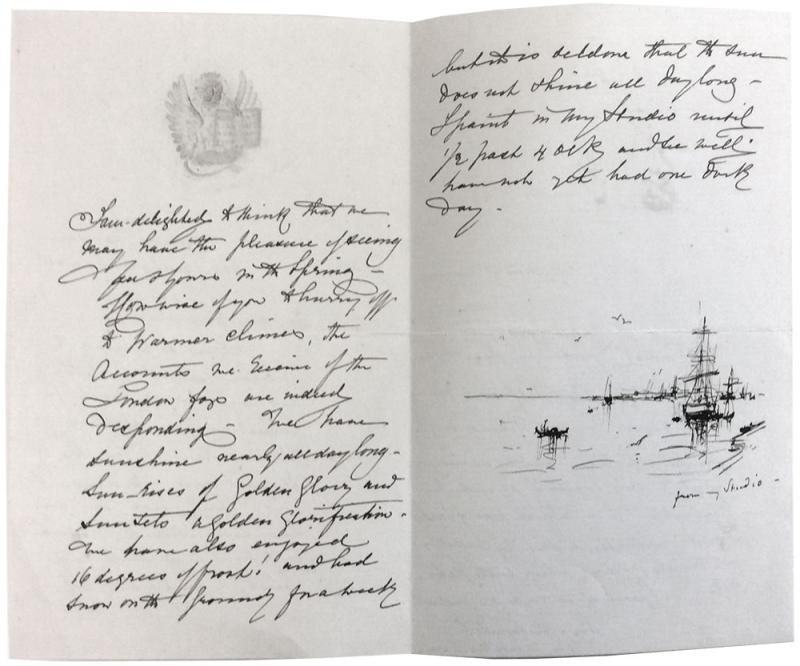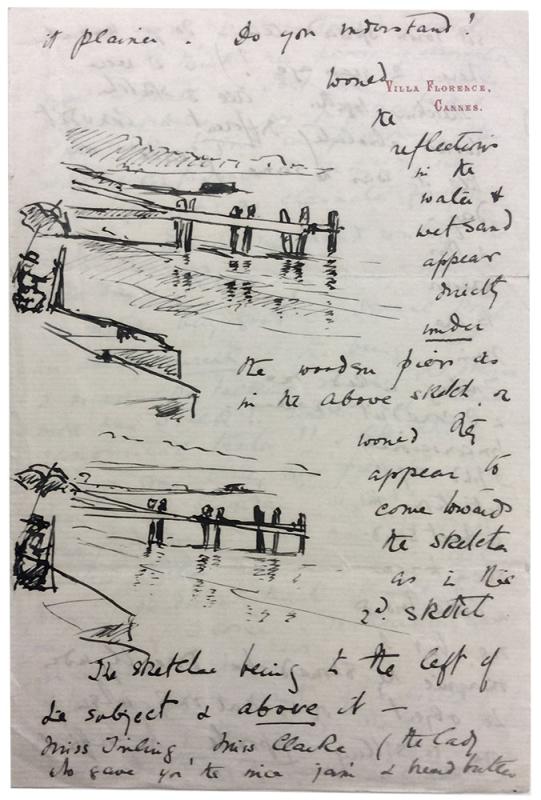Every summer since 2015, a paid undergraduate intern from the University of Pennsylvania’s RealArts@Penn program has joined the Literary and Historical Manuscripts Department staff at the Morgan. Two summers ago, Delaney Keenan (who graduated this June with a B.A. in Art History from Penn) spent part of her internship working on a project to survey and study the department’s holdings of the letters of women artists. The document she produced, full of content summaries, biographical information, and directions for further research, has been the source of multiple selections for the rotating Treasures from the Vault exhibition (I am the staff member primarily responsible for choosing the items from my department to put on view, though I consult with my two departmental colleagues, who also contribute selections). Drawing on Keenan’s work, the fall 2019 rotation included a letter by the nineteenth-century painter Clara Montalba illustrated with sketches of the view from the window of her home in Venice. And this coming fall, we’ll be showing a letter by the eighteenth-century painter Maria Hadfield Cosway, which she concludes with an extraordinary thumbnail version of a now-lost painting, Eros the Love Creator Dividing Chaos.
One of my favorite discoveries from the project has been Amy Benecke. Little is known about her. The 2019 RealArts@Penn intern, Brooke Krancer, helped me to track down some bits and pieces. Around 1914, Benecke published a guidebook, Cannes and Its Surroundings, illustrated with her watercolors of the French resort. A few years earlier, her name turns up on a list of members of the Horace Walpole Society, which was founded in 1911 to “promote the study of the history of British art.” And a painting of hers depicting the marketplace in Sanremo appears to have been chosen for the sixty-sixth exhibition organized by the Royal Institute of Painters in Water Colours in 1884. She has left a pale, watery trail in official art history.
But the single twelve-page letter of hers that ended up at the Morgan (perhaps via a Ruskin connection since her correspondent is Arthur Severn, the husband of Joan Agnew, a cousin of Ruskin’s, and the Morgan has a large Ruskin collection) is a goldmine. From the letter, written around 1894, we get some basic biographical scaffolding: Benecke is a single woman, getting a little older, and she is living with her parents in Cannes. She takes painting classes from a Frenchwoman, a Mademoiselle Something-or-Other (I’ve been unable to decipher the name), and she spends a lot of her time sketching. About all these aspects of her life, she is blunt, unsentimental, and often very funny. For instance, she begins the letter by updating Severn on the state of her parents’ health:
My father is in bed, & very sorry for himself, & really not well, but I don’t think very bad: my mother is also rather seedy, & she always gets anxious & upset when Papa is ill, unlike me — I am an unsympathetic person, with not much feeling unless there is very real cause for it, tho I feel a brute sometimes & presume some day, when I least suspect it I shall be taken aback.
Her parents are not the only people with whom she feels out of sync. A little farther along in the letter, she refers to some friends of hers and wonders:
The strange part to me is, how can such people, such precise, law-abiding, impoetical people find anything in me to like? It makes me feel such a hypocrite — Somehow I often feel as though I were acting horribly, my special friends are all of them, I think, very high toned, & far more stable in their conduct than I am [...] How can a thoroughly strong minded person who never feels the temptation to do things wh. with their mind they feel wrong, be judged in the same category as myself — or anyone with my kind of temperament?
Whether or not she was actually the hypocrite she sees herself as, Benecke certainly seems to be frustrated with the limits of her life. Among the objects of her understandable frustration are 1) boring men, 2) an aging body, and 3) dissatisfaction with her progress as an artist.
For instance, while discussing various books she is reading, she mentions that she has heard that Grant Allen (a Canadian science writer and novelist) has published a book of poems written in his youth. She obviously knows Allen personally, because she comments, “I can’t imagine him a poet can you?” Allen, it seems, is not Benecke’s favorite person. He is not the source of pleasant memories. After speculating that the essays in his other recently published collection, Post-Prandial Philosophy, are probably bad, she recalls a previous interaction in a neat and damning sentence: “I think I shall never get over my last conversation with him — or rather his monologue.”
But only some of the tedium in the world is attributable to Grant Allens and their monologues. Time is passing, and Benecke sees its effects in her body. “Its very depressing living with a man who is very depressed,” she writes, “& sometimes I feel as though all my gaiety had gone for ever, & I don’t like looking into Signor Specchio [the Italian word for “mirror”] who shows me horrible wrinkles & lines. I used to look rather young for my age!! But I don’t now.”
Later, towards the end of the letter, she makes an offhand comment about her health: “What a bore one’s body is.” I hear in this the experience of pain and frailty, and a resolution to endure it by relegating the body to the position of another tedious post-prandial philosopher who can be cuttingly dismissed.
If the body is frail and the company dull, perhaps art is a refuge? For Benecke, this appears to be only partly true. She demolishes the potential rewards of sketching in a single line: “I am sick with disgust when I think how much precious time I have spent in my life on such a useless thing, as sketching — though it does teach one to appreciate nature certainly.”
And in the final pages of the letter, she describes her most recent painting class to Severn. It did not go well. “Très mal dessiné,” her teacher had said of the canvas she was working on, “vos ombres sont sal.” [“Very badly drawn… your shadows are dirty.”] She “put me back to black & white. In the afternoon, she told me to do some anemones.” At which point Benecke throws an all-out, anemone-provoked tantrum and declares that “[j]e ne suis pas en train aujourd’hui, that anything I did would be bad […] I nearly wept. I positively could see no colour or form or anything. Everything I did was bête” [“stupid” or “beastly”]. Though the mademoiselle tries to comfort her and tell her that she simply has a “tempérament trop artistique,” Benecke does not recover her composure and ends the class feeling very discouraged. I imagine that an anemone flower or two might have been stomped on in the course of this session.
One way out of the boredom and frustration is to focus on solving specific problems. About midway through the letter, Benecke tells Severn about a recent sketching outing with two other women. They were sitting by the seaside, near a wooden pier, and debating a question of perspective and reflections, a question that Benecke also poses to Severn: “If you are not opposite to an object, will the reflection of that object be right under the object, or will it come towards you?” Benecke thinks that the reflections of the pier in the water and wet sand would appear to approach the viewer, and she draws two versions of the scene to show Severn what she means.
I don’t know if Severn ever wrote her back with his thoughts on the matter—we rarely have the other sides of correspondences, making much archival work an experience with inadvertent monologues, or at least monologues with a social pretext. But I do love the tiny self-portraits Benecke has drawn in these sketches, since she herself is the sketcher to the left: a hat with a severely flat brim, sharp black lines for her torso, arms, and seated legs, and especially the intensity of the bottom figure, whose body almost touches the canvas as she leans forward.
Sal Robinson
Assistant Curator
The Morgan Library & Museum



